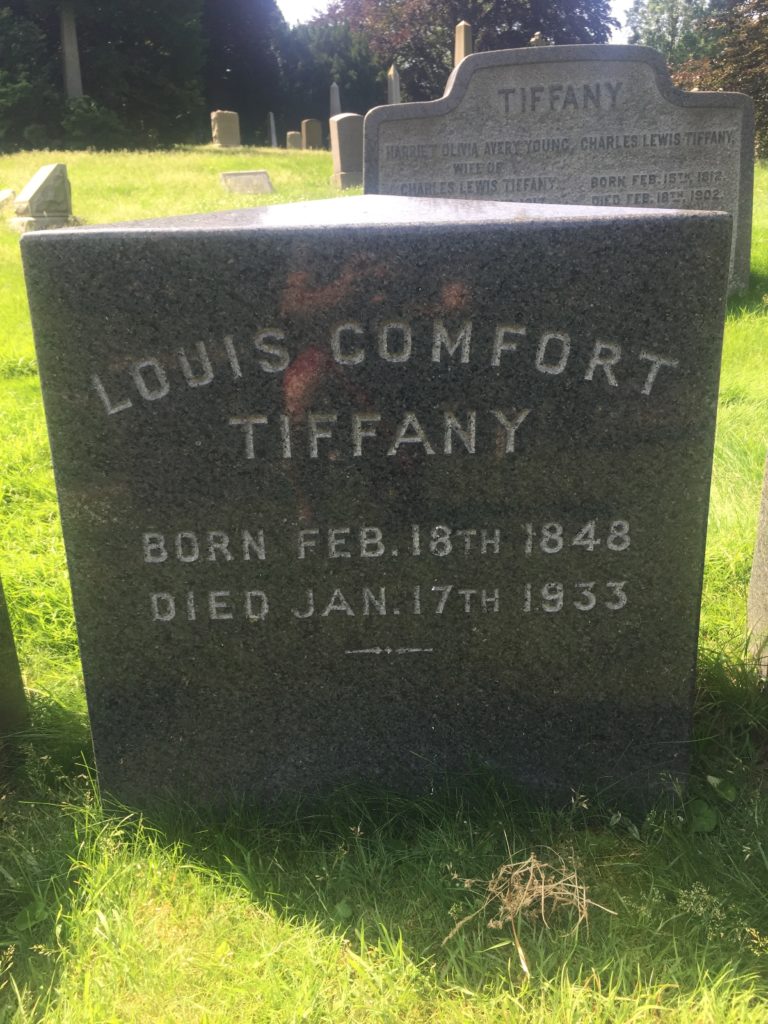Erik Visits an American Grave, Part 601
This is the grave of Louis Tiffany.

Born in 1848 in New York, Tiffany was the son of Charles Lewis Tiffany. You can see his parents in the right corner of this shot, behind their son. I hadn’t heard of the father beforehand or I would have created a separate post for him, but he founded the family jewelry business, created the nation’s first retail catalog, introduced the English standard of sterling silver for imported jewelry and worked with Thomas Edison to create modern theater lighting, especially footlights, transforming the art. So not bad. Louis grew up in this wealth.
Although his parents sent him to military academies for schooling, Tiffany wanted to be a painter. He had some early success in the 1870s, but by 1875, he turned to glassmaking and I think we can all agree this was a good move. His unique and beautiful style was perfectly designed to impress in the ornate Gilded Age, at yet to me at least, he tended to avoid the ridiculousness of a lot of the design of that period. Of course he also had all his father’s connections to build on too. He first got attention for work he did in Mark Twain’s house in Hartford in 1881. The next year, Chester Arthur made a huge stink that he wouldn’t deign to live in the White House until it was redecorated. Tiffany, who was doing a lot of glasswork for Arthur’s rich New York friends, got the job to do a lot of it at the White House, especially in the dining areas. None of this lasted long–Theodore Roosevelt had it all taken out in 1902 and restored to the Federal style–but it made Tiffany famous.
Tiffany established his own firm in 1885. He pretty much had to develop his own glass because it required impurities that a lot of glassmakers did not want to deal with. His use of opalescent glass is really what made him stand out so much and the way he used copper foil allowed him to use a level of detail that was nearly unknown. He built his own glass factory in Queens in 1893 to make what he needed. This is when he started making his famous lamps that are today worth a lot of money. He started showing them at the Chicago famed World’s Columbian Exposition in 1893 and started selling them in 1895. His stained glass windows won a gold medal at the Exposition Universelle in Paris in 1900.
Despite Tiffany getting all the fame, most of his top designers were women who are mostly not remembered by name today. The most prominent was Clara Driscoll. She and others designed many of the floral patterns on the lamps. He employed over 300 artisans at the factory at its peak. In 1902, Tiffany also took over his father’s jewelry company. He continued designing though, including his legendary work at the Palacio de Bellas Artes performing hall in Mexico City, which I can tell you is extremely wonderful work, as is the rest of that amazing building. Tiffany died in 1933, at the age of 84.
Let’s look at some of Tiffany’s work, some of which he had little to do with it but was in his style and in his studio. Going to take stuff from Wikipedia here since the images have usable captions.




The Holy City (1905) – St. John‘s vision on the isle of Patmos, one of eleven Tiffany windows at Brown Memorial Presbyterian Church in Baltimore, Maryland. It has 58 panels and is thought to be one of the largest Tiffany Studios windows
Louis Tiffany is buried in Green Wood Cemetery, Brooklyn, New York.
If you would like this series to visit other American interior designers, you can donate to cover the required expenses here. I can’t find any burial information for Clara Driscoll. Elsie de Wolfe is in Paris and Albert Hadley is in Nashville. Previous posts in this series are archived here.


